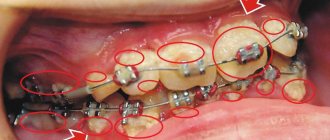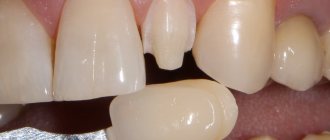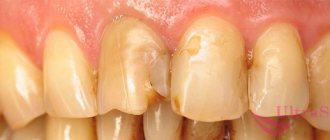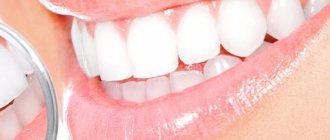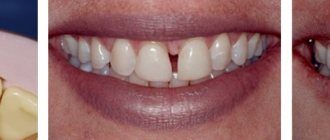Publication date: 03/18/2021
A smile is part of nonverbal communication that is understandable to anyone. Some emotions simply cannot be expressed without a smile. According to research by American scientists:
- 75% of respondents would not want to do business with sad people
- 58% think moody people are hiding something
- 70% would not consider making friends
- 55% would not start working with a gloomy person
With the help of a smile, we invite people to communicate, make friends, thank them, and apologize. A snow-white radiant smile is an indicator of health, beauty and self-confidence. Those with an attractive smile achieve great success not only in their personal lives, but also at work.
The most important component of a contagious smile is straight and white teeth. They are an indicator of health and success. A smile can be light, not exposing your teeth, but when you laugh, you definitely won’t be able to hide them. Therefore, people begin to care about the beauty of a smile in their youth.
Unfortunately, not all people have straight and snow-white teeth. Curvature may appear in childhood, and yellowness may even be an individual feature. Fortunately, dentistry now offers several ways to solve problems with a less-than-perfect smile. For example, veneers or lumineers are installed.
Veneers
Veneers are thin ceramic shells that are attached to the front teeth. To do this, the teeth are ground by 0.3 - 1 mm. Typically, veneers are used to correct not only the color, but also the shape and curvature of teeth. For example, if the teeth are too large or protrude too much forward, and also have interdental gaps.
Veneers are made from ceramics using digital technology. They have high strength, resistance to heat and various types of erosion. Their thickness is 0.3 - 0.6 mm. These veneers can be translucent or opaque.
The service life of veneers ranges from ten to fifteen years. They do not require special care.
How are aligners better than veneers?
Maxim Arkashov, chief physician of the DenMed Dental Medicine Clinic, says:
:
– Patient Anna came to us and wanted to improve her smile. Well, naturally, her first request was to make her veneers. These are ceramic onlays that are placed on your teeth, but for this the teeth need to be sharpened.
Anna, patient
: I wanted exactly them. But Maxim Vladimirovich explained that there are alternative ways to achieve a beautiful smile.
Veneer installation process
Veneers are made to order. Therefore, they perfectly follow the dentition and are not felt at all when worn. At the first visit, an impression of the patient’s teeth is made, it is decided how many teeth the prosthesis will be installed on, and its shade is determined.
To select the optimal color and shape of veneers that suit you, the doctor uses a computer design method. He takes a photo of a smiling face and uses modeling to determine the necessary parameters. You can imagine in advance how suitable the shade and shape of the veneers you have chosen will be.
To install veneers, teeth must be ground down. This is also done at the first appointment. Temporary veneers are then installed, as the wait for the original can be several weeks.
At the next appointment, the dentist removes the temporary veneers and tries on new ones. If they fit perfectly, he places them on special glue:
- A composite material is applied to the treated dentition, the shade of which is selected in advance;
- veneers are fixed and excess material is removed;
- If necessary, grinding is carried out according to the bite.
Do you really need veneers? Or can you still do without them?
I want a beautiful smile and not ruin my teeth with veneers!
Doctor Arkashov
: Sharpening your teeth at a young age is not the best option.
Anna
: How can I make my smile beautiful? It's either veneers or my teeth can be moved into the correct position.
Pros and cons of installing veneers
Veneers can eliminate dental defects, however, they have their positive and negative sides.
The advantages include the following:
- With the help of veneers, you can correct quite severe deficiencies: crooked teeth, enlarged interdental spaces, severe chips.
- correction of the color of teeth if they are pigmented or have an unattractive yellow tint from nature.
The disadvantages of using veneers include grinding off the upper layers of enamel, which entails increased tooth sensitivity. In addition, installing veneers is an irreversible process. After the expiration of the period of use, it is necessary to order new implants.
Braces – orthodontics instead of veneers
Braces are an orthodontic system used to correct bites and eliminate significant interdental spaces. Even short wearing will allow you to cope with:
- diastema - interdental gap;
- uneven arrangement of teeth - protruding forward or slightly recessed.
The benefit of installing braces is a long-term effect and complete correction of dental bite defects.
Contraindications for installing veneers
There are not many contraindications to installing veneers. One of them is installation up to sixteen to eighteen years of age. At this age, the formation of the bite, enamel and teeth is still underway.
Another contraindication is teeth that are too damaged. In this case, there is simply no need to attach a microprosthesis. Here you will have to install an all-ceramic crown. However, if the teeth have been damaged by cervical caries and then restored and filled with aesthetic restoration, then they can be covered with veneers.
Each case is individual and the question of what to choose for correction: veneers or lumineers is decided by the doctor together with the patient.
Where did composite veneers come from?
To understand which veneers - composite or ceramic - are better, let's delve a little into the history of their creation.
In fact, many years ago, when there were no laboratory conditions, there were no normal technicians or materials, many doctors did direct dental restorations. Just then, the first composite materials appeared, from which so-called composite veneers were made directly in the patient’s mouth, providing the patient with beautiful teeth in one go.
Then, after some time, ceramic veneers began to appear. Composite veneers also began to be made by technicians, which was also beautiful, good and quite cheap, because ceramic teeth were more expensive, the work of technicians was more expensive, their training and the materials for production themselves were also more expensive. Composite onlays became a kind of lifesaver, which made it possible to make the cost of veneers very low.
However, many doctors began to refuse this type of restoration, as they began to notice that after some time ( 5-10 years
) snow-white teeth made with composite began to fade, darken - change color and collapse. The search began for materials that serve patients better and longer.
And, of course, ceramic veneers came to the fore, because composite veneers fade over time, they develop gaps, and cracks appear on them. Personally, I, of course, prefer to give the patient porcelain veneers rather than composite.
Dental veneers are also different, there are many different subtypes, that is, these are classic ceramic veneers, these are zirconium veneers, the so-called lumineers. Ceramic veneers
There are also E-Max and feldspathic ceramic veneers when the veneers are made
using a refractor
.
How much do composite veneers cost?
A composite veneer is a cheaper alternative to ceramic veneers; its price can start at 5,000 rubles per tooth. The average price of a composite in Moscow is from 7 to 10 thousand rubles
. Yes, there is no need to be surprised here, composite veneer is a cheaper version of ceramic veneer, it is more developed in Russian regions, because there is no opportunity to create large laboratories and serious costs for materials.
Therefore, this is, of course, an alternative to ceramics, because it is “both cheap and cheerful.” I don’t do such veneers, since their quality can never be compared with ceramics, and it’s not worth talking about how long they last.
What material are composite veneers made from?
These are special technical composites. Special composites are the same plastic. There are different types of composites - this is what dental restorations are made from. The technical composite provides the patient with a quick, beautiful smile, but over time it fades. In this case, if the doctor does them himself, he must have special skills: be able to polish correctly, be able to give shape.
Is it worth installing veneers that fade over time, crack, or darken so much that they cannot be whitened? - this is a serious issue for dentists today.
Lumineers and their features
Lumineers are thin plate-shaped plates 0.2 to 0.3 mm thick made of ceramic that are fixed to the front teeth. The wear life is more than twenty years.
Lumineers are used to correct minor dental defects. Such as: pigmentation, small chips, unattractive shade.
Any implants are installed only on healthy teeth. Therefore, if caries is present, it must be cured.
Lumineers can be installed in just two visits to the dentist.
- At the first appointment, the doctor performs an examination, takes dental impressions and determines the shade of future implants. Sends the impression to an American laboratory, where lumineers are made using the patented Cerinate technology.
- At the second appointment, the dentist performs a professional teeth cleaning. Then the finished lumineers are tried on and installed. The doctor applies etching and primer to the enamel. The inside of the lumineer is coated with a fluoride-enriched composition that strengthens dentin and makes the lumineer resistant to high acidity. The procedure is performed under multiple magnification using a dental microscope. This guarantees the highest precision of implantation. After placing the lumineers on the teeth, the composite solution is dried using a curing lamp. Then the excess cement is removed. The procedure for installing lumineers is complete.
How does the ultranir installation procedure work?
Installation of the onlays takes a total of a week from the moment you contact the clinic. Any medical procedure begins with an initial appointment. This is where you meet the doctor. The doctor carefully examines problem areas,, if necessary, prescribes treatment to prepare the teeth, discusses possible contraindications, and selects the tone of the enamel.
After this, an impression is made of the teeth on which the onlay will be installed. It is important that you can restore one unit, or several at once. The impression is sent to an authorized dental laboratory, where within a week thin ceramic plates are produced that exactly fit the patient.
After this, the onlays are tried on and tightly attached to special dental cement; due to the ultra-thinness of the product, a very good fit can be achieved. The result is a monolithic structure: the onlay cannot accidentally fall off the tooth in ordinary life. The procedure ends with polishing. The entire procedure cycle is painless and does not bring much discomfort.
Pros and cons of installing lumineers
Lumineers correct the color of teeth and correct minor external defects. For example, small chips and slight curvature. However, they cannot sustain serious damage, and in this case it is better to seek installation of veneers.
Another important disadvantage is the price of lumineers. Due to the fact that they will be manufactured using patented technology only in specialized American laboratories, the cost of lumineers is 2-3 times higher than the price of veneers.
However, the advantages of lumineers are undeniable. The most important thing is that there is no need to grind the teeth. This way you can always remove microprostheses and return to their original state.
An important feature of lumineers is their color. They have a matte surface. This makes the smile snow-white and “Hollywood”, however, it does not look entirely natural.
Also, in some cases, if the patient has large teeth, lumineers will add even more volume.
What real high-quality veneers should be like
In the classical sense, veneers are thin, aesthetic overlays, photographs of which you can easily find on the Internet. The smiles of patients before and after their installation are fundamentally different, because the structures hide and correct all minor defects in the frontal area of the front teeth. But they are always non-removable, correspond to all the anatomical features of the patient and the natural color of the dentition, since they are created from casts of the jaws in the clinic’s laboratory, or are applied layer-by-layer to the prepared enamel directly in the dentist’s office. It is important to emphasize that a separate onlay is made for each tooth.
This is a high-quality, time-tested option. Most often, patients choose permanent ceramic veneers. Look at the photos before and after installing such overlays - the smile looks as natural as possible, but at the same time it is devoid of flaws that were there before. There are also permanent onlays made of zirconium dioxide, composite and ceramic composite. The prices for such products are quite high - they can reach 50 thousand rubles per piece (zirconium dioxide).
We see what difference ceramic veneers make
For many people, the cost seems unacceptable, but they really want a beautiful smile. And here, as an alternative to permanent onlays, some sites on the Internet offer different types of removable veneers, which are much more attractive in cost. However, by the way, not a single dentist will recommend them to you. Why? We'll talk about the features and disadvantages of such structures further.
Lumineers or veneers - making a comparison
The difference between veneers and lumineers is as follows:
- veneers are thicker, so you need to grind down the top layer of the tooth
- Lumineers last 10-15 years longer
- veneers look more natural
- Lumineers are much more expensive
Depending on the goals and budget, the patient makes a choice towards one type of prosthetics or another.
In addition, over the years, a small gap may form at the junction of the gum and the veneer attachment, where food debris will accumulate. This can cause caries. Treating caries on teeth with installed veneers is much more difficult and expensive.
Differences between veneers and lumineers
- Thickness of overlays. The thickness of veneers is 0.2 mm, lumineers are 0.07 mm in total. Therefore, when installing lumineers, you can limit yourself to only minimal processing of dental tissues, refraining from preparing them;
- Different methods of fixation. Veneers are attached with dental cement. In turn, to fix lumineers, a special glue is used, which is resistant to moisture and other external factors.
Veneers are significantly inferior in quality to their more expensive counterpart. Food debris often gets clogged under these microprostheses, which provokes the development of carious processes.
What is more expensive: veneers or lumineers?
A short table of price comparisons in Moscow.
| Name of dentistry | Price per tooth, rub. |
| Dental Implantology Center |
|
| Smile studio |
|
| Novadent |
|
| Dentistry "Beauty and Health" |
|
| Smile-at-Once |
|
How long will you have to wait for the result?
Braces exert mechanical pressure on the teeth, due to which they move in the direction specified by the doctor and are gradually aligned. However, this process is not quick, and the patient will have to be patient, because treatment can take more than one year. Especially in those patients who get braces at the age of 30 or later, when the bone structure of the maxillofacial apparatus is already fully formed. Also, do not forget that after treatment with orthodontic appliances you will definitely have to wear retainers, which will help consolidate the result and prevent teeth from moving in the opposite direction. Retainers will need to be worn several times longer than the braces themselves. Sometimes they have to be worn periodically throughout the rest of their lives if the bite has been severely disturbed.
Getting a beautiful smile with veneers would seem to be much faster and easier. You won't have to wait long. Here you just need to spend time waiting for the onlays to be made (in the laboratory this process can take from 1 week to a month), plus make several visits to the dentist and spend several hours in the dental chair. However, here too, patients are sometimes disappointed with the results.
“I wear ceramic veneers, and I’m very pleased that I managed to do without braces. But my situation was not complicated: a pair of front teeth were slightly crooked. By the way, I installed veneers despite negative examples and negative experiences of my friends. I have a friend whose doctor also put on onlays for a minor defect, but they quickly became unusable, and her teeth looked very unpresentable under them. The friend herself later really regretted that she refused treatment with braces!”
Venera, review from correspondence on woman.ru
Questions and answers
Is it true that empress veneers installed in your clinics do not require grinding or removal of enamel?
Good afternoon Please tell me, is it really true that the empress veneers installed in your clinics do not require grinding and removal of enamel? In connection with what?
Hello! To install Empress veneers, grinding of the enamel is required to better attach the veneer and give the teeth an anatomical shape, but the grinding is not as deep as when installing other types of veneers, since Empress veneers are ultra-thin plates made of a unique high-strength material. You can find out more detailed information about the properties of Empress veneers and the features of their installation during a free consultation with our orthopedists. You can make an appointment by calling + 7 (495) 789-42-02. Sincerely, Patient Support Center SIMPLADENT++8 800 333-53-41
Is it possible to hide or disguise a crooked tooth with a veneer?
Good afternoon Tell me, is it possible to hide/disguise it with a veneer if a tooth is crooked? On my right, the fang goes inside the jaw. I don’t want to get braces, and I can’t afford the money for mouthguards. It seems like the solution is veneers, but I need your preliminary advice.
Hello! Theoretically, such defects can be corrected by installing veneers. However, only a doctor can answer you for sure based on the results of the examination. Come to our specialists for a free consultation, the doctor will explain to you all the details of veneer prosthetics and write out a treatment plan indicating the cost. Our clinic uses highly aesthetic Empress veneers made from ultra-strong ceramics. For more details and to sign up for a free consultation, please call +. Sincerely, Patient Support Center SIMPLADENT++8 800 333-53-41
Other questions
Other jobs
What do removable veneers look like?
In appearance, they look like mouth guards or monolithic dentures that are fixed to the entire dentition at once. They are usually made of white plastic, polypropylene or silicone. They can be with or without artificial gum. These veneers are simply placed on the teeth like caps or glued to them. It would seem that this is an ideal solution, if you want it, put it on, if you want it, take it off at any time. There is no need to prepare or grind your teeth for them. But photos before their installation often look even better than after.
Do you think it is possible to notice the difference between the types of veneers?
The fact is that the smile in such overlays is completely unnatural and unnatural, it is too snow-white in color, and the teeth may stick out slightly forward. It most often looks comical, like false ears and mustaches that are used for masquerade. This look is more suitable for some kind of themed party or a prank on friends. For many people, such overlays protrude grotesquely, and in no way hide the flaws of a natural smile from strangers.
Examples of work “Before” and “After”
Restoring aesthetics with lumineers
Case: the patient complained of unsatisfactory aesthetics of the anterior teeth (yellow enamel, curvature).
Aesthetic restoration of anterior teeth - lumineers
Case: the patient complained about the unsatisfactory aesthetics of his smile (he was not satisfied with the color and shape of the teeth), since the teeth were not affected by caries, the curvature was small, the patient chose the most non-traumatic restoration option - installing lumineers without grinding and depulping the teeth.
Press ceramic veneers
Veneers are thin plates fixed to the front of the tooth to hide its defects, such as: unaesthetic enamel color, abnormal tooth shape, chips and large interdental spaces. Ceramic veneers are produced in a dental laboratory using injection molding under high temperature and pressure, resulting in microprostheses that are highly durable and resistant to chewing loads.
Distinctive advantages of such veneers:
- they are light and very thin;
- have a natural color that matches the shade of tooth enamel, which makes it possible to restore even one tooth in this way without losing overall aesthetics;
- hypoallergenic - have full biological compatibility;
- high-strength, unlike products made by the layer-by-layer method;
- have a high precision of fit to the treated surface;
- more durable compared to linings made of composite materials.
The disadvantages of pressed ceramic plates include their high cost, possible instability to excessive loads and, as with most options for this prosthetics, tooth preparation.
Ceramic onlays are the most common type of microprosthetics in orthopedics.
What you need to be prepared for when deciding to install veneers on your teeth
Unfortunately, patients are not always aware of all the points associated with these structures.
- The crown must first be ground. In most cases, when installing veneers, the enamel must be prepared (remove a microscopic layer) - otherwise, the overlay will stick out and provoke an unattractive effect. But in this case, you can choose an alternative - ultra-thin lumineers, which are attached to the enamel without pre-turning, but at a price - they are much more expensive than conventional onlays.
- Not for life! When deciding one day to put veneers on your teeth, be prepared that in a few years you will have to replace them with new ones. Even the best pads won't last a lifetime. If we are talking about composite veneers, they will have to be replaced after 5 – 7 years.
- Beware of caries! Unfortunately, even the best and well-installed structures do not guarantee that caries will not develop under them. Therefore, experts recommend that patients with veneers monitor their oral hygiene even more carefully and undergo regular preventive examinations in the clinic.
- Pleasure is not cheap. This is not only about the beauty of teeth, but also about the need to invest periodically. So, for example, if one pad breaks or comes off, it will have to be replaced with a new one, which also costs money. However, by investing in your health and beauty, you get much more!
Can veneers become a full-fledged alternative to braces?
It’s difficult to call braces and veneers fully interchangeable. For example, in case of serious malocclusions (distal, mesial, deep), if there is a desire to restore the normal functionality of the teeth and improve the aesthetics of the face (for example, it is skewed or asymmetrical due to the incorrect position of the jaw), there can be no alternative to braces. But with small deviations from the norm, with slight crowding, with small interdental spaces, with a slight displacement of the anterior units back, the thinnest linings can easily replace orthodontic devices.
Lumineers Cerinate
The American company Cerinate has developed and patented a technology for the manufacture and installation of ultra-thin lumineers. The manufacturer has been maintaining the highest quality of the microprostheses it creates for several decades now, and this is largely due to the fact that the material for making the onlays is kept secret, and the onlays themselves are developed only in the company itself. However, their installation is also possible in Russian clinics - only doctors who have received a certificate2 of training from Cerinate can work with these lumineers in our country. This is how an American company provides foreign customers with quality products and protects them from counterfeits.
Our clinic prepares for treatment: oral impressions are taken, dental scans are taken, and facial photographs are taken to assess the effect of bite on symmetry. After this, all materials are sent to the USA. Cerinate specialists recreate a 3D model of the patient's jaw. Focusing on it, they develop a set of individual onlays for teeth.
When developing and manufacturing lumineers, three-dimensional computer visualization is used - the process of installing the onlays is carefully studied, which significantly increases the accuracy of their positioning on the teeth. At this stage, the patient can familiarize himself with the final result of the treatment. High-tech robotic equipment is also used to produce the overlays.
A beautiful and snow-white smile for many years! Ceramic veneers and lumineers correct defects, do not stain and even protect teeth!
sign up now
The finished lumineers are sent to the clinic. This usually takes about a month. The overlays are securely fixed with a special glue, its remains are removed and the enamel is polished if necessary.



